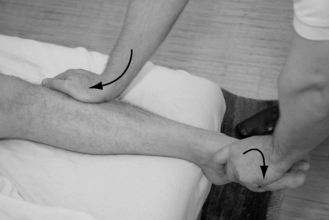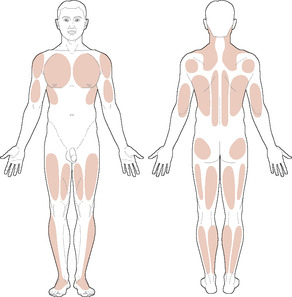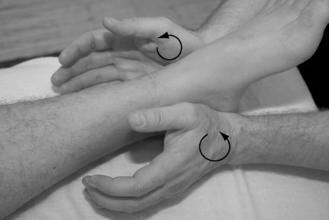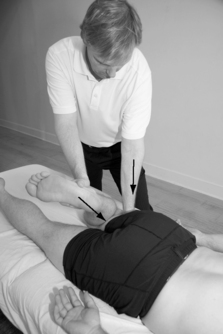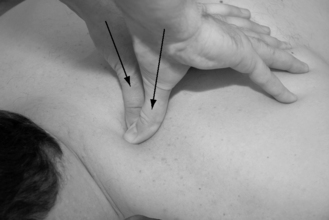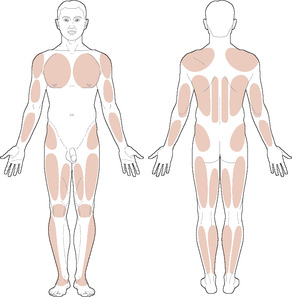5. Sports massage applications for different sports
Event-based sports massage is utilized in a wide range of sports scenarios. Even though the execution of pre-, post-, and interevent massage may share basic principles and fundamentally similar treatment concepts, regardless of sport, different sports can have specific stress areas that may benefit from additional treatment focus. Most sports do use the legs to propel the athlete, however, and so initial attention is more often than not given to different areas of the lower extremities.
It is indicated that muscle stiffness is a risk factor for more severe symptoms of muscle damage after eccentric exercise (McHugh et al. 1999). Research further suggests that increased hamstring flexibility reduces overuse injuries in the lower extremities (Hartig & Henderson 1999), and this may be one reason why today there is a positive trend toward the use of sports massage to benefit athletic recovery and performance (Moraska 2005).
The following examples are suggestions for a few sports-specific treatment areas, based on the principle of suggested higher stress areas, and muscle and/or joint involvement for each stated sport. This is intended to serve as a basic outline for the novice sports massage therapist to more quickly enable assessment of necessary areas, but in many cases the treatments will certainly need to be further tailored to each athlete.
Runners
Most sports include some form of running, but for the devoted runner, areas like legs, hips, and lower back are placed under particular stress. It is suggested it is important for running athletes to have adequate plantar flexion during the push off phase in the running stride (Alter 2004). Shortened hamstrings and/or iliopsoas muscles may additionally shorten the athlete’s stride and need treatment consideration.
Suggested areas to massage on runners (Meagher and Broughton, 1990 and Alter, 2004) (Fig. 5.1)
1. Feet. The feet are important, particularly for long-distance runners, due to the duration of stress.
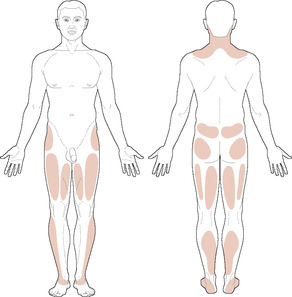 |
| Figure 5.1 |
2. Ankles and lower legs. The muscles affecting the ankles are treated, with special treatment focus on the triceps surae, peroneal, and tibialis anterior muscles (Fig. 5.2).
3. Thighs. Quadriceps femoris, adductors, and the hamstring muscle group.
4. Hips and gluteal area. The gluteal muscles, particularly gluteus medius and minimus, and piriformis. Additionally the TFL and iliopsoas muscle should be attended to.
5. Lower back. Quadratus lumborum and the lower erector spinae muscle.
6. Neck and shoulders. Trapezius, levator scapulae, splenii, and erector spinae.
Swimming
Swimmers generally have great overall flexibility, particularly in areas like the ankles and shoulders. Their elevated ROM makes it necessary to have sufficient muscle strength around the joints to prevent overuse injuries and unnecessary joint stress.
It is suggested that flexibility of the spine is important in swimming (Alter 2004), enabling the body to twist and produce correct power transference.
Suggested areas to massage for swimmers (Fig. 5.3)
2. Knees and thighs. Quadriceps femoris, adductors, and hamstring muscles.
3. Gluteal area and the hip joint. Gluteus maximus, medius, and minimus muscles.
4. Spine. Erector spinae, quadratus lumborum, latissimus dorsi, rhomboids, and trapezius muscles.
5. Shoulders. Infraspinatus, teres major and minor, latissimus dorsi, subscapularis, deltoid, pectoralis major and minor, and serratus anterior muscles.
6. Arms. Triceps brachii, biceps brachii, and brachialis muscles.
Wrestling
Suggested areas to massage for wrestlers (Fig. 5.5)
1. Ankles and calves. Triceps surae, peroneal, tibialis posterior, and tibialis anterior muscles.
 |
| Figure 5.5 |
3. Gluteal and hip area. Gluteus maximus, medius and minimus, TFL, and iliopsoas muscles.
4. Lower back. Quadratus lumborum, erector spinae, and lower latissimus dorsi muscles.
5. Shoulders. Latissimus dorsi, teres major and minor, infraspinatus, subscapularis, deltoid, serratus anterior, and pectoralis major muscles.
6. Neck. Splenius capitis, splenius cervicis, trapezius, levator scapulae (Fig. 5.7), and suboccipital muscle group.
7. Arms. Biceps and triceps brachii muscles.
Olympic weight lifting
Olympic weight lifting requires good flexibility in the ankles, knees, spine, and shoulders to generate the correct technique and necessary power (Alter 2004).
Suggested areas to massage for weight lifters (Meagher and Broughton, 1990 and Alter, 2004) (Fig. 5.8)
2. Ankles and calves. Triceps surae, peroneal, tibialis posterior, and tibialis anterior muscles.
4. Gluteal and hip area. Gluteus maximus, medius and minimus, TFL, and iliopsoas muscles.
5. Lower back. Quadratus lumborum, erector spinae, and lower latissimus dorsi muscles.
6. Spine. Erector spinae, quadratus lumborum, latissimus dorsi, rhomboids, and trapezius muscles.
7. Shoulders. Latissimus dorsi, teres major and minor, infraspinatus, subscapularis, deltoid, serratus anterior, and pectoralis major muscles.
8. Arms. Biceps and triceps brachii muscles. Flexor and extensor muscles of the forearm.
Platform and springboard diving
It is suggested that competitive platform and springboard diving places frequent stress on the wrist, shoulder, and lumbar spine (Rubin 1999).
Suggested areas to massage for platform and springboard divers (Fig. 5.10)
1. Ankles and calves. Triceps surae, peroneal, tibialis posterior, and tibialis anterior muscles.
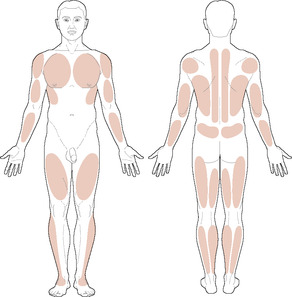 |
| Figure 5.10 |
2. Thighs. Quadriceps femoris, adductors, and hamstring muscles.
3. Lower back. Quadratus lumborum, erector spinae, and lower latissimus dorsi muscles.
4. Spine. Erector spinae, latissimus dorsi, rhomboids, and trapezius muscles.
5. Neck. Splenius capitis, splenius cervicis, trapezius, levator scapulae, and suboccipital muscle group.
6. Shoulders. Teres major and minor, infraspinatus, subscapularis, serratus anterior, and pectoralis major muscles.
7. Arms, wrists, and hands. Triceps brachii, biceps brachii, flexor and extensor muscles of the forearm, and the muscles of the hands.
Golf
The major stress on the body is presented during the actual swing in golf. The movement is repetitive and one sided, which generates an uneven stress on the body. The focus is on the hips, spine, shoulders, and arms.
Suggested areas to massage for golfers (Fig. 5.11)
1. Ankles and calves. Triceps surae, peroneal, and tibialis anterior muscles.
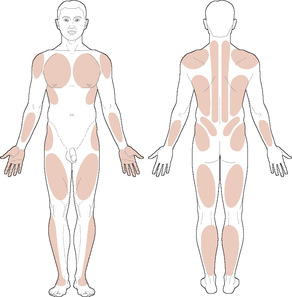 |
| Figure 5.11 |
2. Knees and thighs. Quadriceps femoris, adductors, and hamstring muscles.
3. Hips. Gluteus medius and minimus, TFL, and iliopsoas muscles.
4. Spine. Erector spinae (Fig. 5.12), quadratus lumborum, latissimus dorsi, rhomboids, and trapezius muscles.
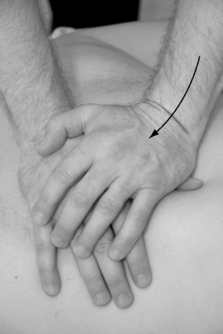 Only gold members can continue reading. Log In or Register to continue
Stay updated, free articles. Join our Telegram channel
Full access? Get Clinical Tree
 Get Clinical Tree app for offline access
Get Clinical Tree app for offline access

|
